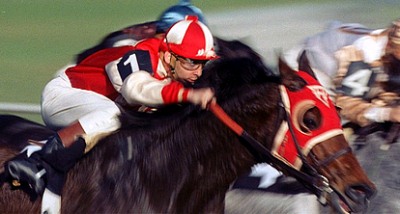




|
6 out of 10 |
 |
|
"Seabiscuit" tells how four unlikely characters: a horse about to be sold for glue, an unemployed salesman, a forgotten loner and a kid, abandoned by his parents become a champion racehorse, a successful owner, a skilled trainer and an expert jockey respectively. "This horse is a real winner", says the trainer, "he's got heart".
The film is a good analogy of the entire era with a horse that is too small, a jockey who is too big, a trainer who is too old and an owner who is too dumb, they all needed to be fixed, just like everything else in the Great Depression, when the economy was broke, unemployment stood at 25% and everybody wanted to be part of an underdog success. For they could relate to a rags to riches story of a 2nd chance horse, Seabiscuit, the underdog, taking on the Millionaires "War Admiral" horse in the "Race of the Century", broadcast on radio on 1st November 1938 and fans supported Seabiscuit, making them cheer nd feel part of better times.
Unlike most sporting movies, it has depth to the characters, for example, the owner, Charles Howard suffers not only the loss of his first son, but his wife blames it entirely on him and leaves him. It poses the clear point: of how a spouse can compound a trauma by being intoerant and lacking in understanding.
Jeff Bridges as the tormented owner really carries the movie, and my compliments go to the slow motion technicians: the quality of the footage of the nose-to-nose racing between the horse really leaves you wondering just who'll win! Regrettably, though, many instances of out-of-focus camerawork, such as the sub-titles, funeral scene and cases of the background trees being in focus whilst the riders and horses, the very subject of the film remain but a blurry smudge, frustrates the eye and makes parts of it unwatchable.
Film Critic:
Paul Wieler |
|